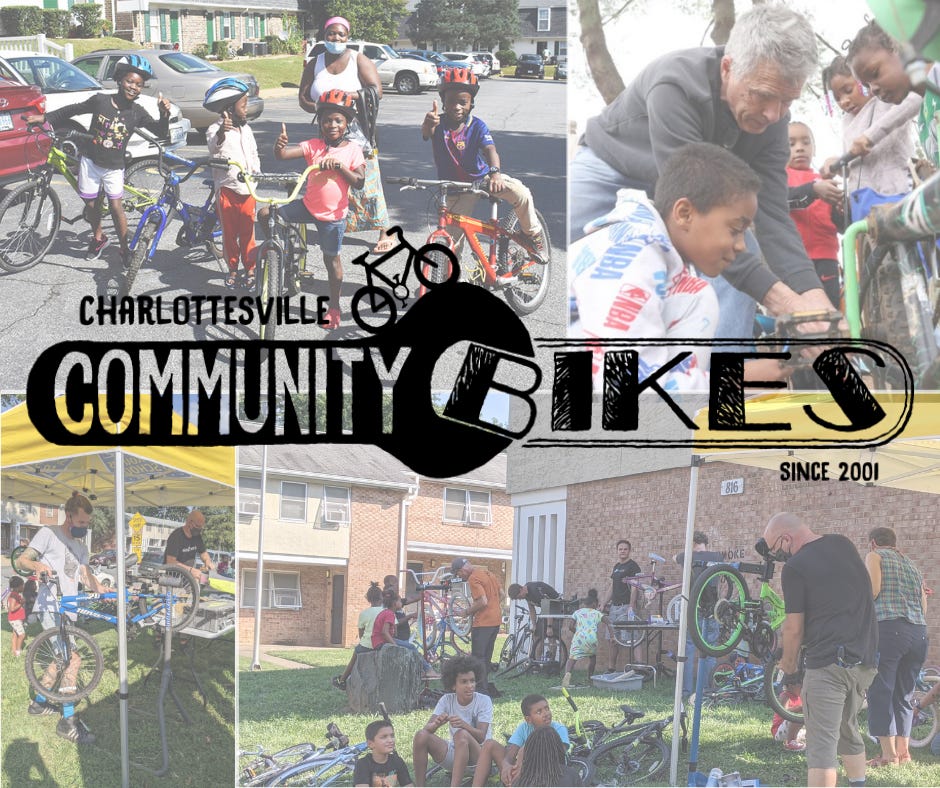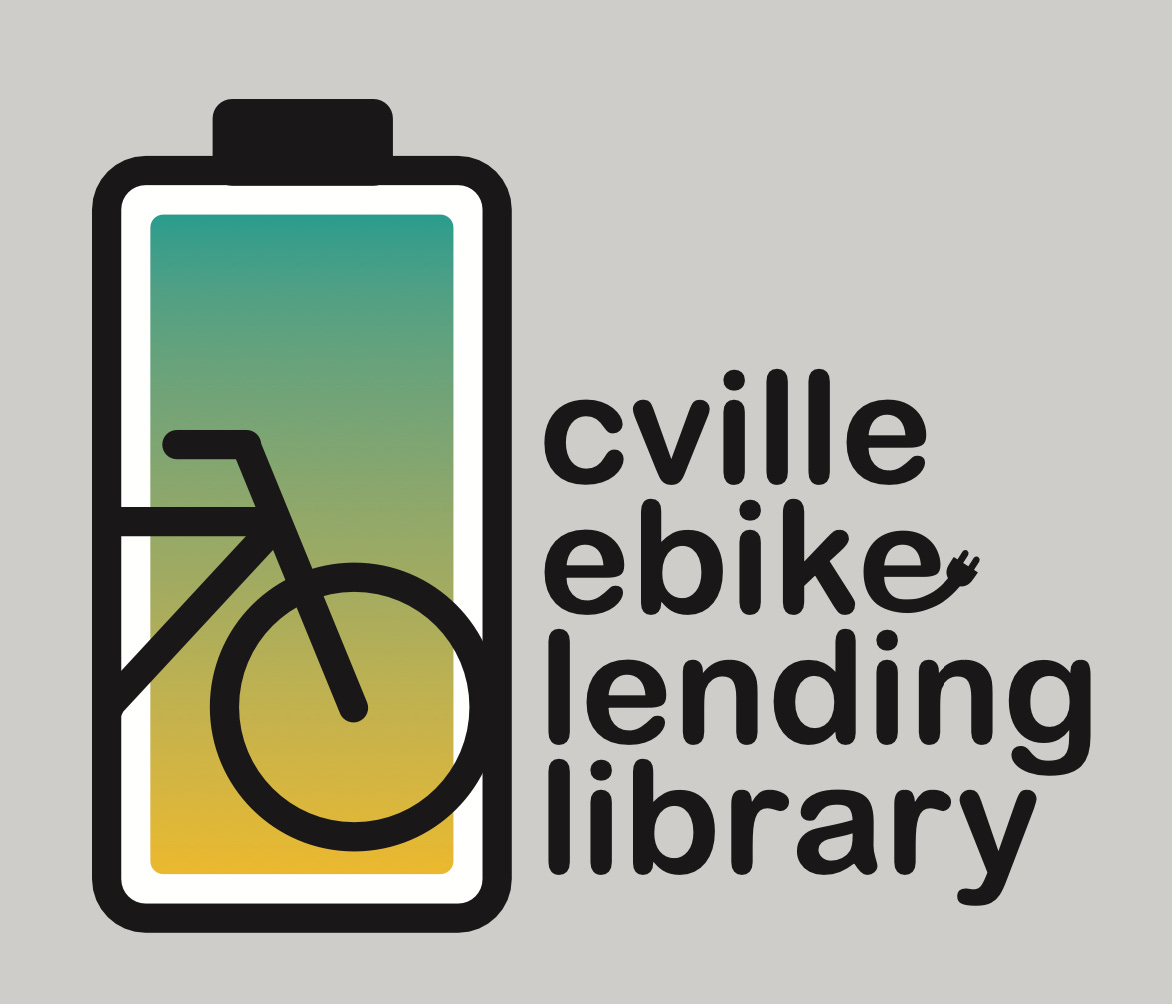November 25, 2024: Albemarle Supervisors get briefing on future public safety obligations as federal funding for firefighters will fade
Plus: The University of Virginia Foundation moves a step closer to building 600 units at North Fork Discovery Park
After today, there are five more Mondays left in the year. That leaves this one, November 25. We are a month away from Christmas and this time around Hannukah begins on the same calendar. The winter holidays are a time to reflect and prepare for the days ahead, and may there be as many as possible for each and every reader of Charlottesville Community Engagement. I’m Sean Tubbs, and I celebrate by writing !
In today’s installment:
The University of Virginia Foundation has asked firms to develop rental housing on 28 acres of the North Fork Discovery
A national think tank has ranked Virginia high on a list of how transparent states are when it comes to making decisions about transportation projects
Charlottesville is trying out ranked-choice voting with a poll to name the annual holiday tree
Albemarle County Supervisors hold a two-hour work session where they get the latest five-year financial forecast from budget staff
First shout-out: Charlottesville Community Bikes
In today’s first subscriber supported shout-out, Charlottesville Community Bikes strives to provide wheels to anyone who needs a ride. That includes:
There’s a Kid’s Bike program for people under the age of 12 (learn more)
Several social services organizations refer people to Charlottesville Community Bikes for access to reliable transportation (learn more)
Keep an eye on their calendar for the next mobile repair clinic (learn more)
There’s also a workforce development program that “blends mentorship and comprehensive training in bicycle mechanics” (learn more)
Do you have some wheels you’re no longer using? Community Bikes accepts all bike and bike-related donations, but at the moment, they are especially slim on adult mountain bikes and need kids' bikes of all sizes.
To learn more, visit their website and consider a donation to keep them rolling!
UVA Foundation seeks firms to build 600 units of mixed-income housing at North Fork
In February, the Albemarle Board of Supervisors approved a rezoning requested by the University of Virginia Foundation that allows up to 1,400 residential units.
This month, the Foundation has issued a request for qualifications from firms to partner on building some of those places to live and to identify financing for construction.
“UVAF intends to select the most qualified development team with demonstrated experience and expertise in thoughtful community design and execution [of] market rate, middle-income and affordable housing development,” reads the RFQ.
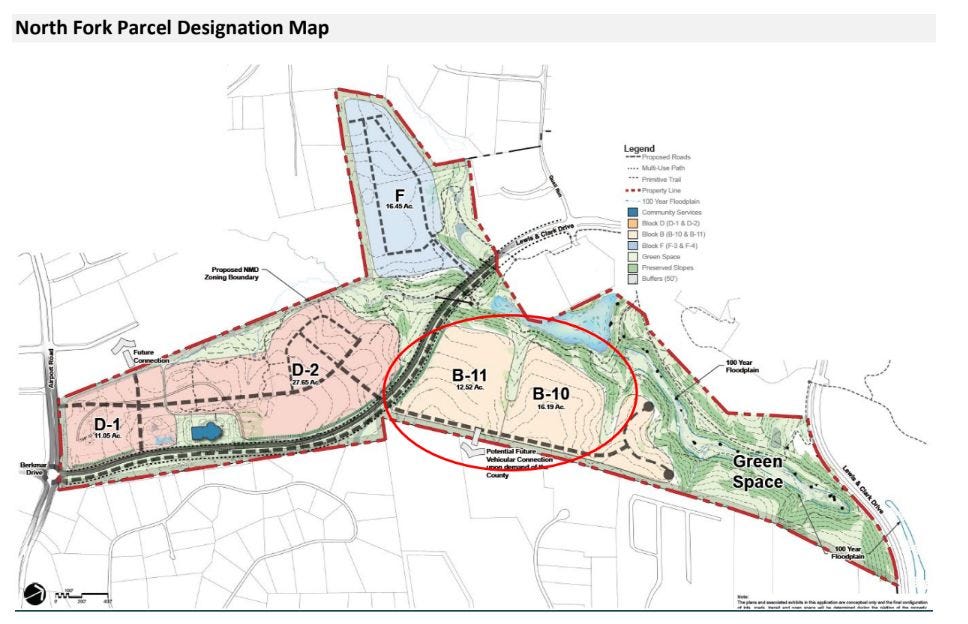
The document defines middle-income as between 80 percent and 120 percent of the area median income, and affordable housing as everything below 80 percent.
The UVA Foundation bought the land for what would become the 562-acre North Fork Discovery Park in 1986. The original zoning to Planned Development Industrial Park allowed as much as 3.7 million square feet of commercial development and so far nine class A office buildings have been constructed totaling around 650,000 square feet.
This year’s rezoning allows for residential to be built on 150 acres, but this specific proposal is for 28 of them and for 300 units.
“UVAF’s goal is to work with a Selected Developer that can create a new community differentiated from others in the area,” the RFQ continues. “Examples of this differentiation could include aspects of innovative, sustainable design and stewardship organized around a community exhibiting excellence in master planning, site and building design and mix of uses.”
One of the project goals states that the focus will be on market rate housing with “strategically” placed affordable and middle-income housing.
The affordable units would be part of a previously announced initiative for UVA and its real estate foundation to build between 1,000 and 1,500 units priced below 80 percent of the area median income.
UVA made selections in August 2023 for two other sites as I reported at the time. The Piedmont Housing Alliance has been selected to redevelop the 12 acre Piedmont site off of Fontaine and a group called Preservation of Affordable Housing is developing a two acre site south at 10th and Wertland. Charlottesville’s Board of Architectural Review had the chance to get an early look in May.
At North Fork, this RFQ is for two parcels of land, each of which would feature 300 units. However, the request does state another approach could also be taken.
At this time, the UVA Foundation intends to retain the land with a ground lease with the developer. At the end of the lease, the units would revert to the foundation.
Statements of qualification are due by January 23, 2025. Questions will be answered publicly and posted to the UVA Foundation’s procurement page.
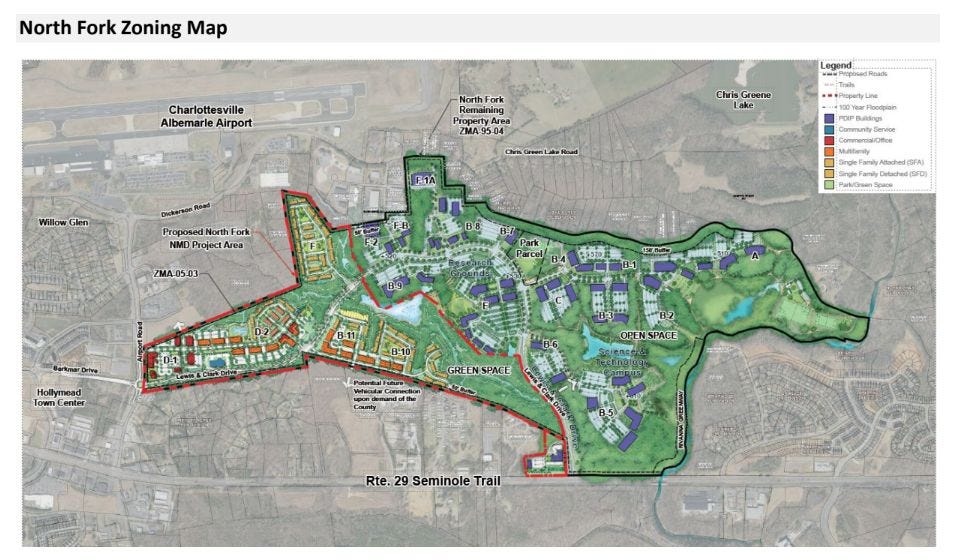
National think-tank ranks Virginia high in survey of transportation transparency
The election of Donald Trump to a second term in the United States presidency likely means a shake-up in the role the federal government plays in building infrastructure. Before that happens, those interested in the topic might consider a November 12 report from the Brookings Institute that reviews the role states play in delivering roads and other ways of getting around.
“States have enormous authority to determine what projects get built, where, and by whom,” reads the executive summary of the report. “Yet states also have a responsibility to invest with purpose and transparency.”
For a sense of scale, the U.S. Department of Transportation sent $61 billion in federal funding to states in fiscal year 2024. One of the authors of the report said many of the governance systems in the county reflect the priorities of the 20th century.
“Between our vehicle-fueled safety crisis, the high costs to drive, and roads being damaged by extreme weather, states can lead by modernizing their investment approaches,” said senior fellow and lead author Adie Tomer in a press release.
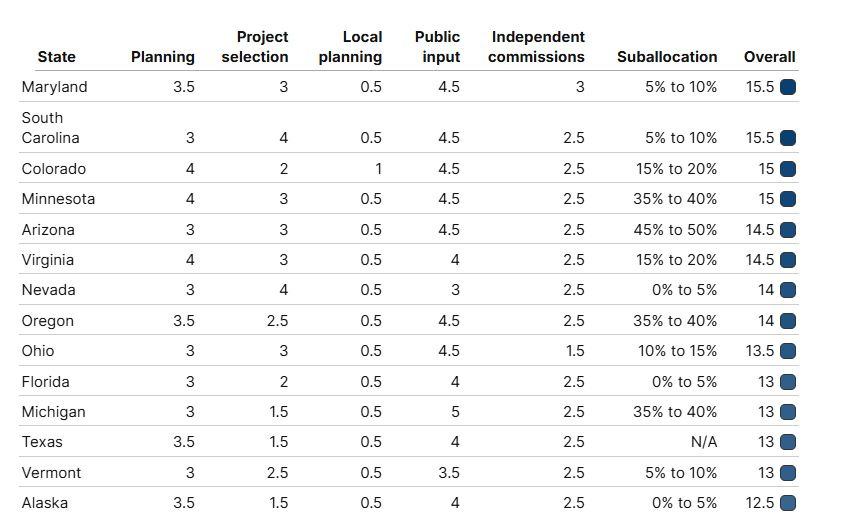
Overall the report finds that most states do not do a good job of providing checks and balances on how money is spent and most states do not publish data on performance metrics.
In the report, Virginia is recognized as being a “promising exception” by having a project selection system that explains what gets funded. That refers to the Smart Scale process that ranks all submissions based on several factors including congestion relief, economic development impacts, and environmental considerations.
The report also notes that Arizona and Michigan that have systems that allow more revenue sharing with localities than other states.
“Generally, states are failing to operate their DOTs in a manner that promotes transparency or helps communities make local investments,” the summary continues. “Yet even with such gaps, there are many promising policies and practices that could be replicated in peer states.”
The report also makes recommendations for change at the Congressional level and notes that the Infrastructure Investment and Jobs Act will expire in 2026. One is that more states create a program like Smart Scale or the Strategic Highway Investment Formula for Tomorrow (SHIFT) program in Kentucky.
The report concludes with a informal scorecard comparing each state and Virginia and Arizona tied for third with a score of 14.5. Virginia received a 4 for planning, a 3 for project selection, a 0.5 for local planning, 4 for public input, and 2.5 for whether there is an independent commission overseeing transportation governance.

Charlottesville using ranked-choice voting to select name for holiday tree
There are 204 days until the Democratic primary in Virginia and so far no candidates for Charlottesville City Council have registered with the Department of Elections.
There are two seats open as the terms of Brian Pinkston and Juandiego Wade expire at the end of 2025. The primary will be the first opportunity for the city to use ranked-choice voting to select nominees for the Democratic Party, but before then Charlottesville will use the system to select a name for the city’s holiday tree.
“In a ranked choice election, people don’t just vote for one candidate,” reads an information release sent out today. “They are given the opportunity to rank all the candidates in their order of preference: your 1st choice, 2nd choice, 3rd choice, and so on.”
In this particular matter, there are four choices. Perhaps you’ll have a hard time choosing between Treelor Swift, Oatmeal III, Spruce Lee, or Boots with Fir? Now you can rank them at the poll here.
“Ranked choice voting helps communities build consensus when there are several different options,” reads the release. “Even if your favorite doesn’t win, you can still help pick the winner with your backup choices.”
A winner will be announced on December 2. The 27th annual Grand Illumination takes place on December 6 at the Ting Pavilion.

Second shout out: Charlottesville E-bike Lending Library
The rolling topography of the Charlottesville area keeps some people away from choosing cycling as an option to get around. Perhaps an e-bike is in order?
That’s where Charlottesville’s eBike Lending Library comes in! E-bikes are a great way to get around the community but there are many brands and styles to choose from. Because many e-bikes are sold online, it can be a challenge to try an e-bike before buying one.
The Charlottesville E-bike Lending Library is a free, not-for-profit service working to expand access to e-bikes in the area. They have a small collection of e-bikes that they lend out to community members for up to a week, for free. You can experience your daily commute, go grocery shopping, or even bike your kids to school, and decide whether e-bikes are right for you. Check out this service at https://www.ebikelibrarycville.org!
Albemarle Supervisors briefed on potential revenue gap in five-year financial work session
The budget development cycle never quite ends in a locality with over 115,000 people. The Albemarle Board of Supervisors adopts an annual revenue and spending document each May after a review process that begins soon afterward. I try to keep up with coverage and you can review previous stories over at Information Charlottesville.
On November 20, Supervisors had a work session on the five-year financial plan.
“Long range financial planning brings together three major components of the County budget: the School Division, General Government, and the Capital Improvement Plan and includes long-range revenue forecasts,” reads an overview on the Albemarle website. “This long-range planning effort guides the development of the annual budget.”
One way the staff keeps track of meeting performance goals is through reporting on the strategic plan adopted by the Board. Supervisors got a briefing on Strategic Plan Execution Analysis and Reporting in September.
“I highlight this because we've been very intentional in the last two years since the Board adopted a strategic plan to tie the budget and the long range plans and the strategic plan together very tightly,” said Andy Bowman, the Assistant Chief Financial Officer for Albemarle County.
A budget depends on the priorities of elected officials and the needs of other stakeholders, such as the Albemarle School Board. Supervisors will have a joint meeting with that elected body on December 4. Bowman said that will give a sense of capital needs which will inform the county’s budget.
Supervisors’ direct involvement with the budget each year begins with a five-year forecast. Bowman said this approach has helped the county in the past.
“I recall several years ago when we were in a five year plan session, the board really had a lot of discussion around revenue diversification,” Bowman said. “And that led when the state authority changed around food and beverage and transient occupancy taxes, the board was well positioned to take action in response to those.”

In May, Supervisors adopted a general fund budget of $437,974,231 for the current fiscal year. Bowman said it is too early to have an exact number for revenues for FY26 but the five-year financial planning and strategic planning framework can give an early glimpse into what shortfalls may occur in the future.
For instance, federal funding to hire dozens of new firefighters and rescue personnel will go away in 2029 as grants run out. That means Albemarle will have to pick up the tab.
“Several years ago when we went into this, we knew with our five year financial planning that as we reached fiscal years 26 and 27, we would feel the financial obligations begin to be a reality for Albemarle County,” said County Executive Jeffrey Richardson.
Richardson said public safety in an area that will need more funding in the immediate future.
For now, Bowman said Albemarle’s economy continues to perform well but an October presentation from Virginia Tech economist Sheryl Bailey did sound off one warning.
“The threat of a recession is not as great right now as it had looked perhaps one year ago and two years ago,” Bowman said. “And while there may not be a recession, Dr. Bailey did recommend it's prudent for us to plan for some cooling that will show up in late 24 to 25 followed by moderate growth.”
Bowman said revenues received so far for FY25 so far are on track to hit their budgetary targets.
County Executive Jeffrey Richardson focused on three strategic plan goals to describe how Albemarle is investing. One of them is “safety and well-being” which include funding for the court system and the Albemarle Charlottesville Regional Jail.
“These are renovations just to bring the jail up to a basic minimum of acceptable design and operational capacity,” Richardson said. “New courts, basically the same thing as with jails. This is modernising and bringing these courts, with the help of and partnership of the city, to a basic level of functionality to be able to deal with today's demands.”
Richardson said under “education and learning” the county is building two new elementary schools and a second high school center. New construction has not happened for years as the county continued a series of expansions.
Under “workforce and customer service” the county executive explained there has been an ongoing need to pay Albemarle employees.
“Two years ago you supported modernization of the classification and pay plan for the balance of the organisation and you received a report last month from our human resources department on how we're doing in a number of areas with key metrics,” Richardson said.
However such investments also create more obligations over time, projecting an increasing need for revenue. Throughout the course of the presentation, Supervisors got a look at how Albemarle’s budget staff plans to cover the rising cost of local government. Some highlights:
Employees in Albemarle County Public School will soon be able to get some health care services done at an in-house clinic, a way that could bring down the overall costs to provide health care.
A new system to monitor community development processes is expected to go live in January as part of the county’s “core systems modernization project”
The General District Court is expected to open in FY26
The Board of Supervisors will soon get an update on the MicroCAT program which has been partially supported with grant funding.
Bowman gave an opening date of December 14 for the opening of the first phase of Biscuit Run Park
Kaki Dimock, the Chief Human Services Office, gave an overview of affordable housing investments made in recent years. She began with some statistics indicating that many people struggle to pay for where they live.
“In March of this year the median home value was $522,000,” Dimock said. “Forty-four percent of renters in our communities spend more than 50 percent of their income on housing. That is severely housing burdened according to HUD's definition. And 16 percent of homeowners spend more than 50 percent of their income on housing.”
Dimock said the Thomas Jefferson Planning District Commission is in the early stages of getting a new regional housing needs assessment and she is fearful the numbers will be even worse.
Albemarle has invested nearly $17.75 million in affordable housing projects in the past five years including Piedmont Housing Alliance’s Hickory Hope’s apartment complex and the Vista29 project that used to be called Premier Circle.
Dimock gave an overview of many of the tools at Albemarle’s disposal such as housing choice vouchers and project based vouchers.
“We provide down payment assistance,” Dimock said. “We have a housing development policy which focuses on density bonus and affordable housing thresholds. We have shelters that we support for people experiencing homelessness and domestic violence, provide emergency financial assistance, housing repair and preservation, primarily through contracts with [the Albemarle Housing Improvement Program.]”
Supervisor Ned Gallaway of the Rio District said budgets are a reflection of the priorities of elected officials, and he wants to make sure the county tackle housing affordability however it can. He noted that Dr. Bailey’s economic outlook had noted a decline in poverty, but he said that likely means people have just left.
“All six counties in the [Thomas Jefferson Planning District Commission] are over 400,000 right now in median housing sales price,” Gallaway said. “So we're not just forcing people out of Albemarle, we're forcing them out of our entire region. And we have two choices. We can accept that or we have to do something to offset that.”
Gallaway said the county should be investing in a housing trust fund that could produce its own revenues through interest. This would help provide funding to nonprofits building units that are rented or sold below the market rate.
Supervisor Ann Mallek of the White Hall District said she appreciated staff for being able to avoid surprises. One such surprise is a need to comply with a federal mandate that fire and rescue personnel provide more oversight of how they handle pharmaceuticals. She said this has thrown localities into disarray.
“Imagine the challenges that we're facing,” Mallek said. “Take that down to a 5,000 person community who doesn't have an extra 100 grand lying around to be able to do something that should never be happening to begin with.”
Supervisor Mike Pruitt of the Scottsville District said his main takeaway from the report is that the county would either need to increase the real property tax rate or reduce spending.
“That would be, frankly, very challenging to identify at the scale that would be needed to close the gap,” Pruitt said.
County Executive Jeffrey Richardson acknowledged there are some challenges facing Albemarle this year that haven’t been seen for a while but the county also does not have a complete picture of revenues for FY26.
“That will happen over the next 30 to 60 days where we get into some detail about what revenue assumptions, both through reassessment and natural growth, what that looks like,” Richardson said.
Pruitt said he did not think the report was grim, but it did indicate the cost of providing services such as reliable fire and rescue service.
“These are the costs that are reflective of living in a kind of high quality and outstanding community like we have that has fire service that is reliable throughout an entirely large county, throughout all our rural areas, which is not a thing that is guaranteed, which is not a thing that is legally required,” Pruitt said.
Pruitt also pointed out that better fire service can lead to lower insurance payments for homeowners.
Supervisor Ned Gallaway said he wanted more information on trends in local government spending.
“ I think that may be helpful for us to understand how expenditures work, how costs, I mean our services, what we're paying for, how that changes over time,” Gallaway said.
The next step in the budget process was a meeting held today of the Audit Review Committee. I’ll try to get that story out some time this week.
Reading material:
Trump nominates Rep. Lori Chavez-DeRemer for secretary of labor, Ginger Christ, Construction Dive, November 25, 2024
Making sense of the 2024 elections as a 21st century paradigm shift, Seth David Radwell, The Fulcrum, November 25, 2024
#768 now ticks over to the next prime number
I will keep this end note short as I am heading over WINA in a moment to say whatever it is I will say. I’ll also note that I had hoped to have more images in the Albemarle budget story. Those will end up in the post on Information Charlottesville.
I also made an error in #767 and got someone’s name wrong. I’ll make a correction later this evening.
Someone today asked me if I had a non-profit arm. I do not. But I am exploring ways for people to fund me in a tax deductible manner. I keep wanting to take some time off from reporting to focus on the business, but there’s so much to write about. I will have to do both.
For now, if you would like to get a paid subscription through Substack, that works. If you are interested in the non-profit idea, let me know via email. I am ready to make some big moves to grow whatever it is I’m doing here.
Paid subscriptions help keep it going. I think you know the deal by now.
If you’d like to become a paid Substack supporter, Ting will match your initial payment. If you sign up for service and you are within Ting’s service area, enter the promo code COMMUNITY you’re going to get:
Free installation
A second month for free
A $75 gift card to the Downtown Mall




